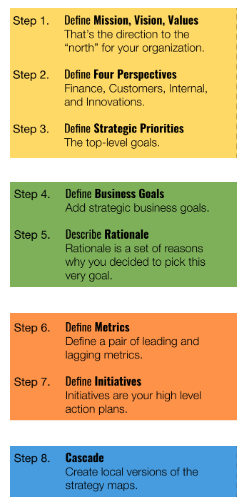Strategy Map
Strategy Map
Dr. Abdulrahman ALJAMOUSS
A strategy map is a diagram that shows your organization's strategy on a single page. It’s great for quickly communicating big-picture objectives to everyone in the company.
With a well-designed strategy map, every employee can know your overall strategy and where they fit in. It helps keep everyone on the same page, and it allows people to see how their jobs affect the company’s strategic objectives.
If you’re using balanced scorecard software, your strategy map will also show how your organization is performing at a glance. Each bubble is automatically colored red, yellow, or green based on your actual measures and the goals you set for them.
This article assumes that you know about the general idea of balanced scorecards. If you’ve never heard of them, don’t worry. We’ve written a short article that will get you up to speed in no time.
Strategy maps come from the Balanced Scorecard (BSC) framework. When it comes to business performance measurement, the authors, David P. Norton and Robert S. Kaplan, advise companies to assess key performance indicators (KPIs) in four core areas:
- Financial perspective: Includes metrics like cash flow, sales performance, operating income, or return on equity.
- Customer perspective: Includes metrics like the percentage of sales from new products, on-time delivery, net promoter score, or share of wallet.
- Internal processes perspective: Includes aspects like unit costs, cycle times, yield, error rates, etc.
- Learning and growth perspective: Includes metrics like employee engagement scores, retention rates of high-performing staff, skill increases of staff, etc.
Strategy Mapping Steps
- Defining Mission and Vision
- Understanding Your Environment
- Defining the Strategy
- Translating the Strategy
- Highlighting the Cause and Effect Relationships
- Showing Themes in Your Strategy Map
- Cascading the Strategy Map
Strategy maps also help
- Discover strategic issues that are not necessarily obvious
- Be effective in evaluating organizational vision, mission, goals, strategies, and actions
- Communicate strategies in an easy-to-understand manner making it easier to implement them
- A way to properly guide, monitor, manage and review strategy implementation
- Stimulate thinking and facilitate conversation and understanding about the strategy

A generic strategy map focuses on four strategic perspectives;
- Financial perspective: outlines the tangible outcomes of the organizational strategy
- Customer perspective: describes the value proposition for the customers
- Internal process perspective: specifies the essential internal processes that will have the greatest impact on the strategy
- Learning and growth perspective: identifies the intangible assets important to the strategy
Mobil North America Marketing and Refining – NAM&R, is one such company. Kaplan and Norton believe that this company “is perhaps our best example of putting the five principles of a Strategy-Focused Organization into practice”. The five strategies they talk about are:
- translate the strategy to operational terms;
- align the organization to the strategy;
- make strategy everyone’s everyday job;
- make strategy a continual process;
- mobilize leadership for change.
One major problem some companies came face to face with, when trying to create the ideal Strategy-Focused Organization, was the impossibility to sustain the energy to deliver the expected results. Even though their managers used everything they learned during the conferences and the seminars and succeeded in creating an appropriate Balanced Scorecard, they couldn’t take the whole process to the next level. The question here is what caused this failure.
The best way of answering this question is by looking at the way in which Mobil NAM&R successfully applied the aforementioned principles. The year was 1992 when things started changing for Mobil NAM&R.
